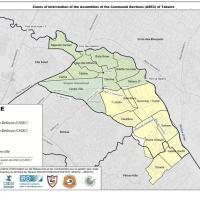Tabarre

Tabarre is an urban commune located in the Port-au-Prince Arrondissement of Haiti’s Ouest Department. The commune is officially part of the Port-au-Prince metropolitan area.
The Commune of Tabarre (Creole Komin Taba), created by the decree of May 13, 2002, is in the department of the West and the district of Port-au-Prince. Tabarre was raised to the rank of Commune during the second term of former President Jean-Bertrand Aristide during the years 2001 – 2003.
Prior to its creation on May 13, 2002, the Tabarre area was considered a part and a rural area of Delmas, located in the Cul-de-Sac Plain. The coat of arms of the Town Hall of Tabarre is represented by two oxen with a cart loaded with sugar cane; a traditional culture of another time, one of the first products of exploitation of the island. Today still the Historical Park of the Sugar Cane remains a symbol of the country and a pride of the Commune.
Historical sites: Tabarre was once a vast flooded plain, an attic producing, among others, sugar cane, fig banana, sweet potato, cassava, calalou, beetroot, and market gardening. It has lost its first vocation to launch, in the name of “development”, in the habitat; as it is unfortunately the case of all the plain of Cul-de-Sac. At the beginning of the 90s, thanks to the construction of the Boulevard 15 Octobre, the fragmentation of the lands extended, that, to the great satisfaction of more than one. This process accelerated into the years 2004-2007 and led to the establishment of numerous commercial enterprises, administrative buildings and the very large US embassy. Despite serious reservations about the use made of this area with great agricultural potential, it is almost unanimous to recognize that in the vicinity of the bustling Port-au-Prince, the immense town of Delmas, the Cité Soleilpowder keg, the vast commune of Croix-des-Bouquets and the imposing Pétion-Ville where perches the superb villas, has built a peaceful corner called Tabarre where until recently it was good to live. Apart from many historic sites found in the colonial home of Caradeux, the town of Tabarre hosts annual popular cultural events such as: Books madness, Music madness, and crafts in celebration to name but a few. A commune that inspired hope toward the end of the 90s saw the beginning of the expansion of Tabarre. Period in which many elements of the middle class and the diaspora saw the residential area indicated to invest their investments. The existence of the residence of President Aristide credited the zone of 24 hours of daily electricity certainly, but the geographical position facilitating the movement of its inhabitants towards Pétion-Ville, Delmas, Port-au-Prince and Croix-des-Bouquets in a record time, was the strong point of this town without even mentioning the lush greenery that was the delight of passersby.
Tabarre is divided into two communal sections, the 3rd and 4th Bellevue and a district. Tabarre is bounded by the communes of Cité Soleil to the northwest, Croix-des-Bouquets to the east, Delmas to the south and Pétion-Ville to the southeast and extends over an area of 2851.5 hectares (24 square km). It is 7 kilometers northeast of downtown Port-au-Prince. It is 48 meters above sea level. The Riviere Grise defines the boundary between the communes of Tabarre and Croix-des-Bouquets. This became the commune’s downtown area.
Demographics: According to the Haitian Institute of Statistics and Informatics (IHSI) (www.ihsi.ht) the estimated population of the Commune for 2012 is 124,330 people, 58,634 men and 65,696 women called “Tabarrois and Tabarroises”.
The Commune of Tabarre is an important industrial and commercial center, being a point of transit for the trade with the Dominican Republic. During the last ten years the municipality has urbanized and now the agricultural surface represents only the 7.61% of the total area of the municipality.
Transportation: The Toussaint Louverture International Airport, with a surface of 261,30 hectares, built in 1965
Education: Dr. Aristide Foundation University (UniFA, 2003), Faculty of Agronomy and Veterinary Medicine of the University of Haiti
Health NPH Hospital (2007)
Utilities: the factories of “Rum Barbancourt” and cigarettes “Il comme fait” “(As it should be)” the State Electricity Bureau of Haiti (EDH)
Security: A police station called: Brigade Motorized Intervention (BIM). The Tabarre Town Hall is located on the boulevard, in Tabarre 25 in a newly built space. l US Embassy (2008)
Location Of US Embassy In Tabarre: Embassy of the United States was constructed recently in Tabarre, in the suburban area just outside the capital Port-au-Prince. Many of the infrastructure and other offices of the United Nations Stabilization Mission in Haiti (MINUSTAH) are also located in Tabarre, such as IOM, and the PMA. The Tabarre Commune is an important industrial and commercial center, being a transit point for trade with the Dominican Republic. During the last ten years the municipality has urbanized and now the agricultural area represents only 7.61% of the total area of the Commune.
The Interim Haiti Recovery Commission headquarters and many ministry offices are currently housed here. The historic gingerbread building in Champs-de-Mars also served as the embassy building for some time. Before this it was a post-colonial building on Rue Bonne Foi which served as the American Legation.
As compared to the rest of Haiti the network for transportation is much better. Dirt roads still serve this place while some paved roads are also seen.
The Port-au-Prince International Airport is the closest to Tabarre at a distance of 3 km.

